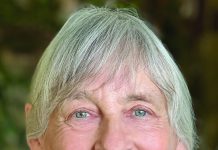Feeling the Heat

The pot boiled over and the soup spilled on the stove. In the overall scheme of things it was just a little incident. But it was indicative of a greater problem; the heat has been turned up for a long time.
The heat I’m talking about is not only the many warm days we’ve been having, so many more than usual. But more visitors, spring breakers. Congested traffic. Tight parking in our neighborhoods almost year round. Our winter peaceful season vanished.
It’s the impression that our city is letting this happen to us, and that city spending is not going to help its residents, but to planning for projects in the central part of town. The downtown that has become the tourist center. The promised village entrance park that continues to stall, waiting for a more grand scheme to materialize. A new cultural arts center? The donation of city funds to local arts institutions while capital improvements in other areas of town languish on lists for future budgets.
Requests for sidewalks on Coast Highway and pathways along Laguna Canyon Road for safety and enjoyment remain unaddressed. Trolleys which seemed a wonderful decongestant at first now seem to be making our beaches more crowded—and they’re often too full to be of practical use for residents.
So when a hillside trolley route was suggested in the South Laguna village all that discontent bubbled up. No, the noise, congestion and intensification of activity was not wanted in the neighborhood. The city offered a test demonstration of the proposed trolley operation. Signs saying “No Trolleys” were out. People were in the streets along the route and others rode along in the bus. It was a demonstration! This was a way to grab onto something specific that could be dealt with right now. It worked. The city staff suggested to the council that the South Laguna route be dropped from the program and the council unanimously agreed. Problem solved.
Except it’s not. City spending that relates to coping with and facilitating visitors is out of balance with income resulting from visitor-serving businesses. Contrary to most assumptions, businesses catering to the tourist economy are not the “lifeblood” of our town. Instead, property tax income, primarily from residences, actually subsidizes much of our overall budget. Local real estate broker and budget analyst John Thomas summarizes: “Income attributable to the tourist economy represents about 25 percent of our city budget, while tourist-related expenses are about 50 percent. It matters to us because local needs are squeezed out in favor of tourist needs. It’s not only the increased police and lifeguard costs; the entire bureaucracy is much larger than comparable cities without substantial tourism. I’m not saying that we shouldn’t have tourism, it just shouldn’t be subsidized by the residents’ taxes.”
Given the large contributions to the budget from residential property tax, why is it that expenditures for improvements and enhancements for neighborhood-supported projects benefiting the community are so scrutinized and reluctantly funded, while much larger amounts are allocated for grand schemes in the tourist core with little questioning?
(The community garden park funding and the “Sunbathers” sculpture restoration come to mind.)
Council members are sensitive to these concerns, it’s just that the overall course of decisions seems to lead inexorably away from our town’s being “a small miracle on the coast of California…a charming village, ” as described in a letter to the editor from a recent visitor from Brooklyn, N.Y. Councilmember Rob ZurSchmiede has stated in the past that he believes that decisions that are good for residents, will ultimately, if indirectly, be good for visitors, too. After all the charm of Laguna for visitors lies in its low-key, informal residential quality. The impression of a happy community that values its small-scale, artistic village surrounded by open space is what visitors seek in journeying from contrasting environments. This all hinges on residents being loyal, content and involved and their neighborhoods being livable environments, not staging areas for tourism.
Landscape architect Ann Christoph is a former council member.





The trolley’s have been subsidized by the federal government through a clean air grant for at least a year if not more.